
 Posted by Pam Hoddinott
Posted by Pam Hoddinott This past July marked a significant change in the lighting industry due to the complete implementation of the Energy Independence and Security Act (EISA). In 2007, the Energy Independence and Security Act was enacted with the goal of reducing energy consumption and promoting energy independence in the United States. Of its many provisions, one of the most important aspects is the phaseout of inefficient lamps or light bulbs. When compared to incandescent bulbs, high-quality LED lights can last anywhere from 20,000 to 50,000 hours longer.
Many organizations are wondering – now that EISA is in full effect – how it will affect their future lighting decisions. While EISA doesn’t ban specific lighting, it does require a minimum efficacy of 45 lumens per watt. Since the incandescent lamps have a lower efficacy, the EISA mandate causes incandescent and halogen lights to now be obsolete. The mandate also generates changes in commercial lighting rebate programs. It’s important to note that advances in LED technology have significantly lowered prices and improved the quality of light.

EISA was passed in hopes to increase energy efficiency,
reduce greenhouse gas emissions, and promote the use of more sustainable lighting options. “Although the law does not explicitly ban any particular lighting type, it mandates a minimum efficacy requirement of 45 lumens per watt (LPW), effectively rendering incandescent and halogen light sources obsolete,” states Briteswitch. Around 30% of light bulbs sold in the U.S. in 2020 were halogen incandescent or incandescent lamps. Almost all of these lamps would not meet the new 45 lm/W standard. Most LED lights meet the 45 lm/W standard, so the actions of the Department of Energy (DOE) are expected to accelerate a transition to LEDs.
Commercial lighting rebate programs have begun adapting their offerings in different ways in anticipation of the implementation of EISA. One way has been by adjusting rebates that are calculated based on watts or kWh savings; another is the removal of incentives for inefficient lights.
Existing programs have made the decision to completely do away with rebates for GSLs (General Service Lamps). Considering the challenge for customers to buy inefficient GSLs after July 1st, the programs have determined that offering rebates for transitioning to LED lighting is no longer necessary.
lighting is no longer necessary.
Several programs began to eliminate incentives for GSLs as early as January, and a large number of programs are phasing out. Various programs will discontinue providing incentives for screw-in lamps such as A19s, PARs, and BRs.
The rebate program feeling it the most right now is the “instant” or “midstream” programs. These are also called “point of purchase” rebates and the discount is taken off the invoice directly at purchase. These rebate programs have focused heavily on screw-in replacement lamps, so they will be affected the most.
Another important adjustment is for standard rebates or incentives that follow a fixed dollar amount per unit of measure, so a rebate is based on energy savings. As customers are no longer able to purchase the old inefficient lighting, certain programs are modifying the baseline used for calculations to accommodate the new 45 lumens per watt limit.
Rebates are still available for most other LEDs and this change will not eliminate lighting rebates as a whole. Rebates remain highly appealing for almost all categories of LED lighting. Currently, active commercial lighting rebate programs cover an impressive 78% of the United States and certain rebate categories are currently reaching their highest levels in history.
There are 31 rebate programs throughout North America that are also providing bonus programs. Organizations offer bonus programs for a limited amount of time to spur participation from customers. Rebates still remain one of the most powerful selling tools for getting lighting projects approved.
The use of halogen and incandescent lights in retail stores has been decreasing due to the widespread adoption of more energy-efficient lighting technologies. With newly implemented energy efficiency standards and regulations encouraging the use of more efficient lighting options, there has been a transition to compact fluorescent lamps (CFLs) or light-emitting diodes (LEDs). These alternative light sources have a longer lifespan and consume less energy compared to traditional incandescent or halogen bulbs. Many retail stores have been transitioning to these energy-efficient options to reduce operational costs, comply with regulations, and improve lighting quality. In recent years, LEDs have grown in popularity because of their significant energy savings, longer lifespans, and versatility in color and lighting control.

If this all seems confusing, Chateau Energy Solutions can assist your organization with turnkey lighting retrofit – from performing a lighting audit to installing a lighting upgrade or retrofit and managing rebates. Our team of experienced professionals specializes in LED lighting retrofits and programs that can reduce energy costs, optimize maintenance, and improve carbon footprint. Chateau Energy will advise, assess, design, implement, administer rebates, finance, and manage projects or entire customized programs. We will provide the solutions you need.
Even with the EISA deadline being a fairly motivating reason to switch to a more efficient lighting source, let us sell you on the benefits of LEDs if you are not familiar. The biggest pro to the LED light is its energy efficiency. LED lights use around 75% to 80% less energy to produce the same amount of light as incandescent bulbs. As mentioned earlier, they also have a much longer lifespan than GSLs lasting 20,000 to 50,000 times longer than incandescent. The overall upfront cost of LEDs might be higher, but the long-term ROI on things like energy cost and maintenance savings far outweigh the initial investment.
For retail stores, LED lighting provides amazing color-rendering properties, allowing products to appear vibrant and true to their colors. This is extremely important for stores selling products like jewelry or cosmetics. Another benefit for retailers is LED directional ability. LED lights can be easily directed and focused, allowing retailers to highlight certain merchandise or specific areas of the store.
LEDs also have dimming and lighting control capabilities. LED lights have controls that can allow retailers to dim or adjust brightness based on things like time of day, natural light, or amount of people in the store to save energy and money. LED bulbs do not produce the high level of heat that is given off from incandescent bulbs. This excess heat coming from the incandescent bulbs can heat up a store or office and require the use of more AC to keep a cool environment, which will increase the overall costs on the monthly bill.
Overall, LED lighting offers numerous advantages over incandescent and halogen bulbs, and the benefits make LED a popular choice for any organization looking to reduce light costs, save energy, and have more flexibility with their lighting.
If your organization is ready to upgrade to energy-efficient LEDs, contact Chateau Energy. Forget about the burdensome research, paperwork, and process. Let our lighting experts manage the rebate process for you and find a way to economically implement energy-efficient technologies.
Mason Lassiter is a dynamic Marketing Associate with a passion for creativity and a relentless drive for results. He is an Atlanta native and a graduate of the University of South Carolina with a communications degree in Public Relations. As part of the Chateau Energy Solutions team, Mason’s mission is to craft compelling marketing strategies that captivate audiences and drive business growth. Beyond the office, Mason enjoys golfing, personal fitness, and attending any Atlanta sports team’s game. Contact Mason on LinkedIn.
Chateau Energy Solutions Making Energy an Asset®
Ready to get started on the path to energy efficiency and sustainability?